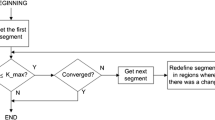Abstract
EEG segments recorded during microsleep events were transformed to the frequency domain and were subsequently clustered without the common summation of power densities in spectral bands. Any knowledge about the number of clusters didn’t exist. The hierarchical agglomerative clustering procedures were terminated with several standard measures of intracluster and intercluster variances. The results were inconsistent. The winner histogram of Self-organizing maps showed also no evidence. The analysis of the U-matrix together with the watershed transform, a method from image processing, resulted in separable clusters. As in many other procedures the number of clusters was determined with one threshold parameter. The proposed method is working fully automatically.
Access this chapter
Tax calculation will be finalised at checkout
Purchases are for personal use only
Preview
Unable to display preview. Download preview PDF.
Similar content being viewed by others
References
Thorpy, MJ; Yager, J; The Encyclopedia of Sleep and Sleep Disorders; NewYork: Facts on File, 1991.
Santamaria, J; Chiappa, KH; The EEG of Drowsiness in Normal Adults; J Clin Neurol; 4(4), 1987, 327–382.
Liberson, WT; Liberson, CT; EEG recordings, reaction times, eye movements, respiration and mental content during drowsiness; Proc Soc Biol Psychiat, 19, 1966, 295–302.
SAS Institute Inc., SAS/STAT User’s Guide, Version 6, Fourth Edition, Volume 1, Cary, NC: SAS Institute Inc., 1989, 943 pp.
Milligan, GW; Cooper, MC; An examination of procedures for determining the number of clusters in a data set; Psychometrika, 50(2), 1985, 159–179.
Deichsel, G; Trampisch, H; Clusteranalyse und Diskriminanzanalyse; Gustav Fisher Verlag, Stuttgart, 1985.
Backhaus, K; Erichson, B; Plinke, W; Weiber, R; Multivariate Analyseverfahren; (6. Aufl.), Berlin, Heidelberg, New York. Springer, 1996.
Kohonen, T; Self-organized formation of topologically correct feature maps; Biol Cybern, 43, 1982, 59–69.
Kohonen, T; Self-Organizing Maps; 3rd edition, Springer, Berlin, 2000.
Fritzke, B; Wachsende Zellstrukturen-ein selbstorganisierendes neuronales Netzwerkmodell; PhD thesis; University of Erlangen, 1992 (in german).
Villmann, T; Topologieerhaltung in selbstorganisierenden neuronalen Merkmalskarten; PhD thesis, University of Leipzig, 1996 (in german).
Ultsch, A; Siemon, HP; Exploratory Data Analysis: Using Kohonen Networks on Transputers; Univ. of Dortmund, Technical Report 329, Dortmund, Dec1989.
Costa, JAF; Netto, MLA; Estimating the Number of Clusters in Multivariate Data by Self-Organizing Maps; Int. J Neural Systems, 9(3), 1999, 195–202.
Vincent, L; Soille, P; Watersheds in Digital Spaces: An Efficient Algorithm Based on Immersion Simulation; IEEE Transaction on Pattern Analysis and Machine Intelligence, 1991.
Bauer, HU; Pawelzik, KR; Quantifying the neighborhood preservation of Self-Organizing Feature Maps. IEEE Trans. Neural Networks, 3(4), 1992, 570–579.
Author information
Authors and Affiliations
Editor information
Editors and Affiliations
Rights and permissions
Copyright information
© 2001 Springer-Verlag Berlin Heidelberg
About this paper
Cite this paper
Sommer, D., Golz, M. (2001). Clustering of EEG-Segments Using Hierarchical Agglomerative Methods and Self-Organizing Maps. In: Dorffner, G., Bischof, H., Hornik, K. (eds) Artificial Neural Networks — ICANN 2001. ICANN 2001. Lecture Notes in Computer Science, vol 2130. Springer, Berlin, Heidelberg. https://doi.org/10.1007/3-540-44668-0_90
Download citation
DOI: https://doi.org/10.1007/3-540-44668-0_90
Published:
Publisher Name: Springer, Berlin, Heidelberg
Print ISBN: 978-3-540-42486-4
Online ISBN: 978-3-540-44668-2
eBook Packages: Springer Book Archive




